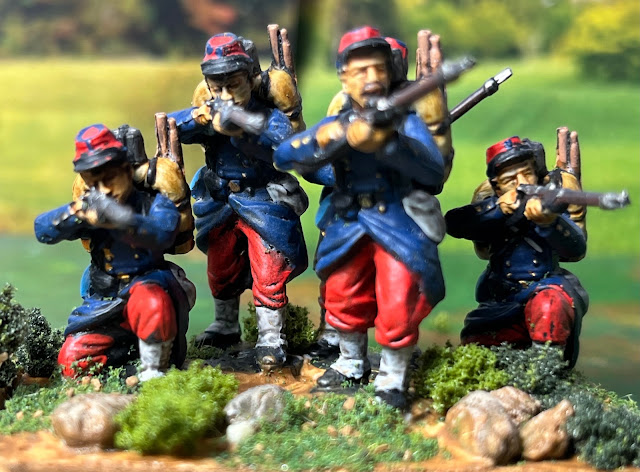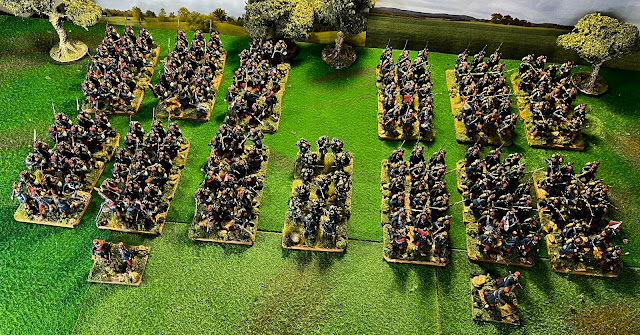With the completion of the third battalion of the 55e Régiment (below) the infantry of the First Brigade and consequently the First Division, 2nd Corps is completed.
 |
The German army of 1870 maintained a full corps structure in peacetime for all operational arms complete with staff and supply services, but the larger part of the French army was not so well organised with only four permanent formations of corps size. Of those four permanent formations three of them, the Imperial Guard, the Garrison of Paris and the Garrison of Lyon, existed more for the maintenance of public order than for military purposes, while the organisation of the corps at the Camp of Instruction at Châlons was transient. This latter corps was comprised of the regiments that went to Châlons for the three month summer manoeuvers. They were formed into brigades and divisions with the relevant support services for the duration of their manoeuvers, but those formations were broken up at the end of the manoeuvers and the regiments sent back to their regular posts.
When war broke out in July 1870 there was a fear that the Germans would make a sudden strike into northeastern France from the Palatinate. To block such a strike the troops at Châlons, because of their relative state of readiness, were designated 2nd Corps, ordered to draw what equipment was needed from the store houses of Châlons and sent forward toward the frontier. The reservists were to join their regiments in their forward position.
The corps consisted of three divisions, each identically structured with two infantry brigades (the first consisting of a Chasseur battalion and two line regiments, the second consisting of two line regiments) and three batteries (2 of 4lb field guns and one of mitrailleuses), a cavalry division of two brigades (each of two regiments) and a corps artillery reserve of six batteries (2 of 4lb field guns, 2 of 12lb field gin and 2 of 4lb horse artillery). This structure was used by 2nd, 4th, 5th and 7th Corps in the initial mobilisation. The 1st, 3rd and 6th Corps, each commanded by a Marshal of France, had an additional infantry division, an additional cavalry brigade and in the case of 1st and 6th Corps two additional batteries in the corps reserve.
The full order of battle for First Division, 2nd Corps at the outbreak of the war was:
1st Division Général de Division Charles N. Vergé
1st Brigade Général de Brigade Charles R. Latellier-Valazé
3rd Chasseurs à Pied – Commandant Thoma
32nd Regiment Colonel Merle
1st Battalion – Commandant Collingnon
2nd Battalion – Commandant Bazaille
3rd Battalion – Commandant Lapasset
55th Regiment Colonel de Waldner-Frauendstein
1st Battalion – Commandant Millot
2nd Battalion – Commandant Damei
3rd Battalion – Commandant Chanon
2nd Brigade Général de Brigade Charles J. Jolivet
76th Regiment Colonel Brice
1st Battalion – Commandant de Brauneck
2nd Battalion – Commandant Dubrurgua
3rd Battalion – Commandant Jammais
77th Regiment Colonel Fevrier
1st Battalion – Commandant Mezerin
2nd Battalion – Commandant Rembert
3rd Battalion – Commandant Lemonfagner
Divisional Artillery Commandant Rey
5th Battery, 5th Regiment (batterie de 4) – Captain Maréchal
6th Battery, 5th Regiment (Mitrailleuse) – Captain Besancon
12th Battery, 5th Regiment (batterie de 4) – Captain Martimor
9th Company, 3rd Engineers Regiment - Captain Bonnal
Here is the full division, deployed in column of divisions, First Brigade on the left, the Second Brigade on the right and the Chasseurs in the middle.
 |
| First Brigade |
 |
| Second Brigade |
The divisional artillery will be purchased towards the end of the month.
Commanding First Division, was général de division Charles Nicolas Vergé. Born at Toul in 1809 he was the only general officer in 2nd Corps who had not had a formal military eduction, yet he was the most combat experienced of them all. Serving as fourrier in a detachment of Parisian volunteers in 1831, he went to Algeria later that year and served there for the next twenty-one years, rising steadily through the ranks while serving successively in the Zouaves, Foreign Legion, Spahis, Chasseurs d'Afrique, Tirailleurs Algerienne, 36th line, 8th Light and 27th line. He went to the Crimea where he fought at the Alma and Sevastopol, later receiving promotion to général de brigade in 1855, commanding Second Brigade, Second Division, 2nd Corps. For his services in the Crimea he received a Médaille de Crimée from Turkey and was made Knight Commander of the Order of the Bath by the British Government. In Italy he commanded a brigade in Bourbaki's Division, 3rd Corps, but did not see action at Solferino. Promoted to général de division in March 1861 he took command of the First Division at Châlons in March 1870 which he led at Spicheren, Rezonville, Gravelotte and Noiseville. He surrendered at Metz and was interned until the end of hostilities.
After the war he commanded a division in the Versailles Army that retook Paris from the Communards and later commanded Twelfth Division, 6th Corps until his retirement in 1874. He died at Versailles in 1893 and was buried at Fontainebleau. The church of Notre Dame d'Ecrouves, just outside Toul, has a stained glass window (below) dedicated to him.







You’ve accomplished a major milestone here. What a wonderful sight.
ReplyDeleteThanks Jonathan...exactly one-third of the way through the infantry!
DeleteVery impressive Mark. The figures in the first couple of pictures are quite dynamic, and I especially like the kneeling bugler. Verge seems quite the soldier.
ReplyDeleteThanks Lawrence. Yes there is a bit of kit bashing in this batch - the bugler being one and the fanion bearer being another. Vergé seems to have been quite an effective leader as were a number of the French divisional and brigade commanders, but they were badly let down by higher commanders (and the Emperor) who weren't up to the task.
DeleteThat is a very impressive combat record for such a senior commander, Mark!
ReplyDeleteThose Second Empire commanders certainly got around.
DeleteWhat a spectacular sight! I really like the conversions such as the bugler, which is very effective. A nice piece on the background history to and of Verge himself:).
ReplyDeleteThanks Steve. There are quite a few more kit bashed figures coming.
DeleteOutstanding! Great and interesting information and a very amazing looking Corps. Well done sir!
ReplyDeleteThanks Mark...I have started in the next division.
DeleteQuite impressive and only partially done? Thank you for the background on the units and the commander's story.
ReplyDeleteLooking forward to more units and the AAR'S they will generate.
Thanks Joe. The next phase is started...
DeleteFantastic Mark…
ReplyDeleteAnd still only a third of the army.
All the best. Aly
Thanks Aly...Yes ONLY a third...it's a bit daunting, but a project I do want completed.
DeleteAn impressive amount of figures. They look great of course. Good luck with the next two thirds. Do they also have red pants? 😀
ReplyDeleteThanks Stew, that is 208 figures in all. That means 416 to go, of which 386 will indeed have red pants!
DeleteSplendid looking force! One third in no time!
ReplyDeleteBest Iain
Thanks Iain.
DeleteAwesome collection!
ReplyDeleteThank you Rens
Delete